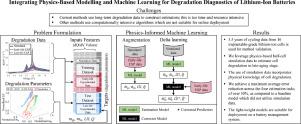Energy Storage Materials ( IF 18.9 ) Pub Date : 2022-05-28 , DOI: 10.1016/j.ensm.2022.05.047 Adam Thelen , Yu Hui Lui , Sheng Shen , Simon Laflamme , Shan Hu , Hui Ye , Chao Hu

|
Traditional lithium-ion (Li-ion) battery state of health (SOH) estimation methodologies that focused on estimating present cell capacity do not provide sufficient information to determine the cell's lifecycle stage or value in second-life use. Quantifying the underlying degradation modes that cause capacity fade can give further insight into the electrochemical state of the cell and provide more detailed health information such as the remaining active materials and lithium inventory. However, current physics-based methods for degradation diagnostics require long-term cycling data and are computationally expensive to deploy locally on a device. To improve upon current methods, we propose and extensively test two light-weight physics-informed machine learning methods for online estimating the capacity of a battery cell and diagnosing its primary degradation modes using only limited early-life experimental degradation data. To enable late-life prediction (e.g. > 1.5 years) without the use of late-life experimental data, each of the methods is trained using simulation data from a physics-based half-cell model and early-life (e.g. < 3 months) degradation data obtained from cycling tests. The proposed methods are comprehensively evaluated using data from a long-term (3.5 years) cycling experiment of 16 implantable-grade Li-ion cells cycled under two temperatures and C-rates. Results from a four-fold cross-validation study show that the proposed physics-informed machine learning models are capable of improving the estimation accuracy of cell capacity and the state of three primary degradation modes by over 50% compared to a purely data-driven approach. Additionally, this work provides insights into the role of temperature and C-rate in cell degradation.
中文翻译:

集成基于物理的建模和机器学习,用于锂离子电池的退化诊断
传统的锂离子 (Li-ion) 电池健康状态 (SOH) 估计方法侧重于估计当前电池容量,无法提供足够的信息来确定电池的生命周期阶段或二次使用中的价值。量化导致容量衰减的潜在退化模式可以进一步了解电池的电化学状态,并提供更详细的健康信息,例如剩余的活性材料和锂库存。然而,当前基于物理的退化诊断方法需要长期的循环数据,并且在设备上本地部署的计算成本很高。为了改进现有的方法,我们提出并广泛测试了两种基于物理的轻量级机器学习方法,用于在线估计电池容量并仅使用有限的早期实验退化数据诊断其主要退化模式。为了在不使用晚期实验数据的情况下实现晚期寿命预测(例如 > 1.5 年),每种方法都使用来自基于物理的半电池模型和早期寿命(例如 < 3 个月)的模拟数据进行训练从循环测试中获得的降解数据。使用来自在两种温度和 C 速率下循环的 16 个可植入级锂离子电池的长期(3.5 年)循环实验数据对所提出的方法进行了全面评估。四重交叉验证研究的结果表明,与纯粹的数据驱动方法相比,所提出的基于物理的机器学习模型能够将电池容量和三种主要退化模式状态的估计精度提高 50% 以上. 此外,这项工作提供了对温度和 C 速率在细胞降解中的作用的见解。











































 京公网安备 11010802027423号
京公网安备 11010802027423号